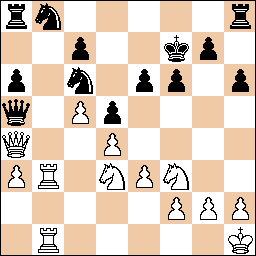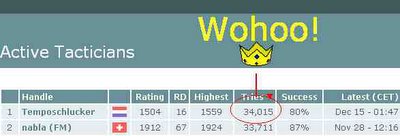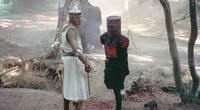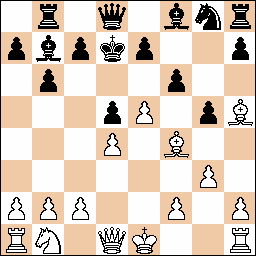Saturday, December 31, 2005
A long time ago...
The mistakes list was intended to see how someone's performance in standard games was progressing over time. One difficulty in using it is it does not track your opponent's level of play. Even if you are improving, playing someone who is way over your head will likely push you into more mistakes, and those games make the list look like you are slipping backwards.
I present this as freely usable for personal or educational purposes only. Email me if you want to publish this or any parts of this. It may prove useful to someone out there, especially under 1500 folks. Modify to suit your own needs.
Mistakes List
| Mistake | Explanation |
| Haste | Acting like under time pressure when not |
| Time Pressure | Need to manage time better |
| Mouse Slip | OTB - Didn't write down the move first with plenty of time |
| Opening Error | Neglecting development breaking from principals |
| Questionable/Weak Move | |
| Easy Positional Error | Weak center or squares inaccurate defense Knight on edge etc. |
| Medium Positional Error | When 2 or 3 factors needed to be considered |
| Difficult Positional Error | When 4+ factors needed to be considered |
| King Safety Error | Unforced loosening of King's defenders or bad King moves |
| Back and 7th Rank Problems | Both offense and defense |
| Lost Tempo | When other moves were better |
| Lost Initiative | When it could have been preserved |
| Bad Plan or Tunnel Vision | When you failed to fully examine what was called for |
| No Plan | |
| After the Move Problem | Blocking your defenders, accidentally opening or closing lines, etc. |
| Forgot What I Saw Earlier | Could be anything, like abandoning defense of other pieces |
| Weak/Inferior Pawn Structure | |
| Failed To Retreat | When there were other alternatives |
| Moved Into Mate | Calculating inaccuracies |
| Missed Mate | |
| Stalemate Problems | Allowed perpetual check thoughtless promotion etc. |
| Bad Trade | When a trade of loses advantage |
| In Over Your Head | Getting into positions beyond your ability to play |
| Easy Endgame Blunder | When a won/drawn game becomes drawn/lost |
| Medium Endgame Blunder | When a won/drawn game becomes drawn/lost |
| Difficult Endgame Blunder | When a won/drawn game becomes drawn/lost |
| Easy Endgame Mistake | When only some advantage is lost |
| Medium Endgame Mistake | When only some advantage is lost |
| Difficult Endgame Mistake | When only some advantage is lost |
| Tactical Level of Error | Simple clear and forced tactics are as below |
| (Include Missed Mate) | Add 1-6 for unclear positions 1-4 for many variations 2-8 for combinations |
| 0 | Blunder of not immediately taking |
| 1 | |
| 2 | Your opponent takes your hanging piece |
| 3 | |
| 4 | You miss a pin fork skewer or unstoppable threat |
| 5 | |
| 6 | You give your opponent a pin fork skewer or unstoppable threat |
| 7 | |
| 8 | You miss a 2 move threat or tactic |
| 9 | |
| 10 | You give your opponent a 2 move threat or tactic |
| 11 | |
| 12 | You miss a 3 move threat or tactic |
| 13 | |
| 14 | You give your opponent a 3 move threat or tactic |
| 15 | |
| 16 | You miss a 4 move threat or tactic |
| 17 | |
| 18 | You give your opponent a 4 move threat or tactic |
| 19 | |
| 20 | You miss a 5 move threat or tactic |
| 21 | |
| 22+ |
-=-=-=-=-
Example game:
[Event "?"]
[Site "?"]
[Date "2004.11.05"]
[Round "?"]
[White "Chessmaster"]
[Black "kingofthespill"]
[Result "1-0"]
[PlyCount "57"]
[EventDate "2004.??.??"]
1. Nf3 d5 2. d4 Nf6 3. c4 e6 4. Bg5 Bb4+ 5. Nc3 O-O 6. e3 Nbd7 7. Bd3 Bxc3+ 8.
bxc3 b6 9. cxd5 exd5 10. O-O h6 11. Bh4 g5 12. Bg3 Re8 13. Qc2 Ne4 14. c4 Nxg3
15. hxg3 Nf6 16. cxd5 Bb7 17. e4 Qe7 18. Rfe1 Rac8 19. Ne5 c5 20. dxc6 Qb4 21.
Bc4 Rxe5 22. Rab1 Rxe4 23. Rxe4 Qxb1+ 24. Qxb1 Bxc6 25. Re7 Bd5 26. Qf5 Rxc4
27. Qxf6 Rc6 28. Re8+ Kh7 29. Rh8# 1-0 paste below game into this link:Mistake 11/5/04, Black Haste 26 Time Pressure Mouse Slip Opening Error Questionable/Weak Move 7 Easy Positional Error Medium Positional Error 17 Difficult Positional Error King Safety Error 11 Back and 7th Rank Problems Lost Tempo Lost Initiative Bad Plan or Tunnel Vision 16, 19, 20 No Plan After the Move Problem 16 Forgot What I Saw Earlier Weak/Inferior Pawn Structure Failed To Retreat Moved Into Mate Missed Mate Stalemate Problems Bad Trade In Over Your Head 22 Easy Endgame Blunder Medium Endgame Blunder Difficult Endgame Blunder Easy Endgame Mistake Medium Endgame Mistake Difficult Endgame Mistake Tactical Level of Error (Include Missed Mate) 0 16 1 2 3 19 4 5 6 7 8 9 10 27 11 12 13 22 14 15 16 17 18 19 20 23 21 22+
Saturday, December 24, 2005
2005+1
I am getting back into TCT. No push towards finishing, just daily practice. I hope this next year brings more accurate combinations and brilliancies to me and all of my fellow Knight Errants.
TCT Results | Circle 1 | Circle 2 | Circle 3 | Circle 4 |
| Step 1 | 97% | 99% | 99% | 100%r |
| Step 2 | 93% | 96% | 95% | 97% |
| Step 3 | 93% | 97% | 97% | 96% |
| Step 4 | 80% | 86% | 90% | 92% |
| Step 5 | 74% | 77% | 83% | 92%* |
Then What? II

Let's face it, to me this is it, the then what that loses or wins games at crucial moments. I'm not talking about combinations, just simple checks, threats, and captures. The day after my last post I was still working on the above problem because of this unclear sub-variation. I'll tell you in advance that I didn't get it right. Mind you I worked through this problem about 9 months ago 7 times, and even reviewed it twice. Lesson learned: never grow old!
Back to the story. Starting from the the above question, I worked through a variety of Knight moves just to prove they were bad, although something in the back of my mind signaled "mate threat" on the right side of the board. All I could see after 32 Nde5+ fxe5 33 Nxe5+ Kg8 was Ng6, threatening the Rook when the White Queen hangs. I filed it away for later. I couldn't see much difference in the remaining obvious choices 34. Qxa5 or Rxb8. In my mind they were close, both eventually leaving White with a positional advantage and an extra pawn, and Black suffering with a difficult to promote a6 pawn and a backward e6 pawn. I did attempt a long, complete evaluation of both, posted below interspersed with Fritz corrections. I worked through the e6 pawn capture below, also. I went back and thought about adding the Knight to g6 idea, but I couldn't see it do anything good for the position, and therefore didn't change my opinion of either one.
I had a clue, though; 33... Kc8 wasn't chosen by a chess computer. Neither line was as bad as 33... Kf6, so I figured I did something wrong. After some frustration I plugged it into Fritz to find out why. Arrrrg. If you can see which of these choices for 34 is overwhelmingly better, you probably do have the potential to become a master. I just have difficulty realizing there was a line opened along the b1-h7 diagonal, a4-d1 diagonal, and that the King can be forced to move to a vulnerable square. Silly me.
I may be nitpicking, but I think Seirawan did this problem a disservice by leaving this out of his analysis in Winning Chess Tactics, not to mention he had marked this as intermediate as opposed to professional level difficulty. Bad GM!
-=-=-=-=-
Fritz's best in bold, all White +- winning lines, but only one clear best one for White. rn5r/2p2kp1/p1n1pp1p/q1PpN3/Q2P4/PR2PN2/5PPP/1R5K b - - 0 1
1. Nde5+ fxe5 2. Nxe5+ Kg8 3. Rxb8+
(3. Qxa5 Nxa5 4. Rxb8+ Rxb8 5. Rxb8+ Kh7 6.Rxh8+ Kxh8)
3... Rxb8 4. Rxb8+ Kh7?? {This is my idea. I was thinking the Rooks could x-ray protect each other. Strangely 4...Nxb8 Qxa5 +13.00 is marked as best. Urp.} 5. Qc2+ {this line is open !? *smack forehead*} 5...g6 6.Qxg6#
$1 (5. Rxh8+ Kxh8 6. Qxa5 Nxa5 7.Nf7+ Kg8 8. Nd8 e5 9. dxe5 Nc4 10. e6 Kf8 11. Nc6 Nxa3 12. Nb4 Ke7 13. Nxd5+Kxe6 14. Nxc7+ Kd7 15. Nxa6)
(5. Qxa5 Nxa5 6. Nd7
(6. Rxh8+ Kxh8 7. Nf7+ Kg8 8.Nd8 e5 9. dxe5 Nc4 10. e6 Kf8 11. Nc6 Nxa3)
6... Rxb8 7. Nxb8 Kg6 8. Nxa6 c6 9.Nb8 Kf5 10. Nd7 Nc4 11. a4 Ke4 12. Ne5 Nxe5 13. dxe5 d4 14. exd4 Kxd4 15. a5Kxc5 16. f4 g6 17. g4 Kb5 18. f5 gxf5 19. gxf5 exf5 20. e6) *
-=-=-=-=-
Wednesday, December 21, 2005
Then What?
(32.) White to move.

Deep Thought vs Mephisto
21st North American Computer Chess Championship
New York, Nov 11-14, 1990
1 Nf3 d5 2 e3 Nf6 3 c4 e6 4 Be2 Nc6 5 d4 Bb4+ 6 Bd2 O-O 7
Bxb4 Nxb4 8 a3 Nc6 9 O-O Na5 10 c5 b6 11 b4 Nc6 12 Nc3 bxc5
13 bxc5 Qe7 14 Rb1 Bd7 15 Bb5 Rfb8 16 Qa4 Nd8 17 Bxd7 Nxd7
18 Qa5 Rc8 19 Nb5 a6 20 Nc3 Qf6 21 Rb3 Qg6 22 Rfb1 f6 23
R1b2 h6 24 Kh1 Qd3 25 Ne2 Qd1+ 26 Nfg1 Nc6 27 Qa4 Ndb8 28
Nf4 Kf7 29 Nd3 Rh8 30 Rb1 Qd2 31 Nf3 Qa5 32 Nde5+ fxe5 33
Nxe5+ Kf6 34 Qxa5 Nxa5 35 Rxb8 Rhxb8 36 Rxb8 Rxb8 37 Nd7+
Ke7 38 Nxb8 Nc4 39 Nxa6 Kd8 40 a4 Nb2 41 Kg1 Nxa4 42 Kf1 Kd7
43 f3 Nc3 44 Nb8+ Kc8 45 Nc6 Kd7 46 Ne5+ Ke7 47 Ke1 g5 48
Kd2 Nb5 49 Kc2 Kf6 50 Kb3 Na7 51 Kb4 h5 52 Ka5 Nc8 53 g4
hxg4 54 fxg4 Ne7 55 Ka6 Ng8 56 Kb7 Ke7 57 Kxc7 Nf6 58 c6
Ne8+ 59 Kc8 Kd6 60 Kb7 1-0
It's easy to see the Knight sacrifice/Knight forking the overworked Black Knight and Black King idea, but then what? It's usually one of the weaker variations that I will have difficulty calculating, and sometimes not seeing that a square is going to be clear like the f6 square here.
I bumped into this "then what" difficulty in reviewing my book circles. My habit seems to have been to first get a very accurate hunch about a combination being in a position, correctly find the first move, then screw it up somewhere later. This calculation difficulty is still a problem, and it's as if the circles have only chipped away at the edges of it. Part of this problem is software. TCT isn't all that strong in its determining whether you know every continuation or not, although it occasionally does play some weaker continuation moves that forces you down some of those paths.
I haven't thought about "then what" for quite awhile. It was a one of things that made me seriously study tactics. Back a couple of years ago, I could usually work my opponent ( i.e. beginner) into some sort of tactical position that I rarely played right. Nowadays I find my opponents are usually more accurate and give away less tactical opportunities. The over 1800 crowd seems to be much better at creating those situations, that's for sure. I need to get my positional knowledge beefed up after these cirles are done so I can deal with it better on both offense and defense.
P.S. I just had this happen again as White. Sloppy game...arg.
White to Move.
m
m
The pawn "sacrifice" e6+ seemed almost obvious, though later I found it was not the strongest. Unfortunately, I couldn't see the best moves after he (inaccurately) took it even with plenty of time.
11.e6+ Kxe6 12.Qg4+ f5 13.Qe2+ Kd7 14.Bxg5 Nf6 15.Bxf6?! exf6 16.Nd2
Fritz has this:
1. +- (5.00): 12.Qe2+ Kd7 13.Bg4+ Ke8 14.Be6 h5 15.Qb5+ c6 16.Qd3 Rh6 17.Bxb8 Qxb8 18.Bxg8
2. +- (3.41): 12.Qg4+ f5 13.Qe2+ Kd7 14.Be5 Nf6 15.Bf7 e6 16.Bxe6+ Kc6 17.Nc3 Ba8 18.Nxd5 Nxd5
1.Nf3 Nc6 2.g3 b6 3.Bg2 Bb7 4.d3 Nd4 5.e4 Nxf3+ 6.Bxf3 d5 7.e5 Rb8 8.d4 f6 9.Bf4 g510.Bh5+ Kd7 11.e6+ Kxe6 12.Qg4+ f5 13.Qe2+ Kd7 14.Bxg5 Nf6 15.Bxf6 exf6 16.Nd2 Bb417.O-O-O Bxd2+ 18.Rxd2 c6 19.Re1 Kc8 20.Qe6+ Qd7 21.Qxf6 Rd8 22.Re7 Qd6 23.Qxf5+Rd7 24.Rde2 Kc7 25.Qxh7 Bc8 26.Rxd7+ Bxd7 27.Bg4 Rd8 28.Re7 a5 29.Rxd7+ Rxd7 30.Qxd7+Qxd7 31.Bxd7 Kxd7 32.a4 Ke6 33.Kd2 Kf5 34.Ke3 Kg4 35.f3+ Kg5 36.h4+ Kh5 37.f4 Kg438.c3 c5 39.dxc5 bxc5 40.b3 Kf5 41.h5 Kf6 42.g4 Kg7 43.g5 Kf7 44.f5 Kg7 45.h6+ Kh746.Kf4 d4 47.cxd4 cxd4 48.Ke4 {Black resigns} 1-0
Friday, December 16, 2005
More 5334 Talk
-=-=-=-=-
When it comes to real chess, I am still pretty clueless. You know, the exclamation mark moves, like those you find in CT-Art. I sometimes refer to this as the other game of chess.
Medium: 4793, 4809, 4812, 4831, 4851
All involve attacks on either the f2 or f7 pawn.
Harder: 4899, 4901, 4904, 4954, 4957
All involve attacks on either the g2 or g7 pawn.
They have a known thematic move to be played in the diagram, so calculating is actually simpler than in real life. Some are forced mate, others are simply getting a winning advantage. They all look like fairly weird moves but with work, sometimes alot of work, they make sense.
TCT Results | Circle 1 | Circle 2 | Circle 3 | Circle 4 |
| Step 1 | 97% | 99% | 99% | 100%r |
| Step 2 | 93% | 96% | 95% | 97% |
| Step 3 | 93% | 97% | 97% | 96% |
| Step 4 | 80% | 86% | 90% | 92% |
| Step 5 | 74% | 77% | 83% | ??% |
Wednesday, December 14, 2005
Congratulations Tempo

I just happen to look on the CTS server and lo and behold, Tempo, you are the King of CTS. You may not consider yourself graduated, but this is an equivalent achievement to me and definitely worth celebrating.
I now study 40+ minutes daily with TCT. I am doing my best to just focus on the problem in front of me and forget about finishing any particular circle. A part of me certainly does want to be done. Based on other people's experience, that quality of the circles wearing on me seems like par for the course.
TCT Results | Circle 1 | Circle 2 | Circle 3 | Circle 4 |
| Step 1 | 97% | 99% | 99% | 100%r |
| Step 2 | 93% | 96% | 95% | 97% |
| Step 3 | 93% | 97% | 97% | 96% |
| Step 4 | 80% | 86% | 90% | 92% |
| Step 5 | 74% | 77% | 83% | ??% |
Wednesday, December 07, 2005
Stupidity Repellent
Wouldn't that be great?! You could charge a pretty penny for it, too. To some degree, that's what I hope to get from all this chess study. As of yet, I have not found any appropriate repellent in liquid or tablet form, so I suppose the circles will have to do.
I think that many good points about CTS have been made on J'adoube's latest post, both pro and con.
I have used CTS more since my last post, maybe 10-15 problems several days a week. I certainly don't think I have used it enough to draw any new conclusions, but I agree with Tempo that the major weakness is lack of integrated mechanism for problem repetition. It obviously isn't a panacea, I agree with J'adoube's points on the importance of good opening and middlegame play. Nonetheless, I like CTS for what it is, and use it to find where my tactical blind spots are.
I want to add that I do not like to guess using CTS. I attempt to really see the essential idea before playing any move. I could care less about the timer, but if my percentage falls below 80 percent, that's the signal to me that I am guessing. If my rating drops on the server, I take it to mean that I am tired. No big deal.
One cool CTS interface idea I thought of was a vision mode - i.e. rather than seeing your opponent's move they just put in the text move.
-=-=-=-=-
TCT Results | Circle 1 | Circle 2 | Circle 3 | Circle 4 |
| Step 1 | 97% | 99% | 99% | 100%r |
| Step 2 | 93% | 96% | 95% | 97% |
| Step 3 | 93% | 97% | 97% | 96% |
| Step 4 | 80% | 86% | 90% | 92%* |
| Step 5 | 74% | 77% | 83% | ??% |
Saturday, December 03, 2005
Black Knights

Although I am doing ok with the problems, I feel myself lagging. I am really getting to the point of just wanting to be done with these circles. I think I will at least aim for using some holiday time to eliminate Step 2 and perhaps even Step 3 once and for all.
-=-=-=-=-
Here's a pin-breaking tactic that came up recently. White to move.
TCT Results | Circle 1 | Circle 2 | Circle 3 | Circle 4 |
| Step 1 | 97% | 99% | 99% | 100%r |
| Step 2 | 93% | 96% | 95% | 97% |
| Step 3 | 93% | 97% | 97% | 96% |
| Step 4 | 80% | 86% | 90% | 91%* |
| Step 5 | 74% | 77% | 83% | ??% |


